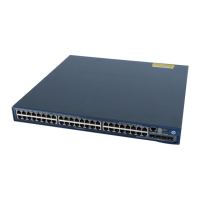88
With the TC-BPDU guard function, you can set the maximum number of immediate forwarding address
entry flushes that the switch can perform within a specified period of time after it receives the first TC-
BPDU. For TC-BPDUs received in excess of the limit, the switch performs forwarding address entry flush
only when the time period expires. This prevents frequent flushing of forwarding address entries.
Follow these steps to enable TC-BPDU guard:
Enable the TC-BPDU guard function
Optional
Enabled by default.
Configure the maximum number of
forwarding address entry flushes that the
device can perform within a specific time
period after it receives the first TC-BPDU
stp tc-protection threshold
number
NOTE:
HP does not recommend you to disable this feature.
Enabling BPDU drop
In an STP-enabled network, after receiving BPDUs, a device performs STP calculation according to the
received BPDUs and forwards received BPDUs to other devices in the network. This allows malicious
attackers to attack the network by forging BPDUs. By continuously sending forged BPDUs, they can make
all the devices in the network perform STP calculations all the time. As a result, problems such as CPU
overload and BPDU protocol status errors occur.
To avoid this problem, you can enable BPDU drop on ports. A BPDU drop-enabled port does not receive
any BPDUs and is invulnerable to forged BPDU attacks.
Follow these steps to enable BPDU drop on an Ethernet interface:
Enter Ethernet interface view
interface interface-type interface-
number
Enable BPDU drop on the current
interface
Required
Disabled by default.
Displaying and maintaining MSTP
Display information about abnormally
blocked ports
display stp abnormal-port [ | { begin |
exclude | include } regular-expression ]
Display BPDU statistics on ports
display stp bpdu-statistics [ interface
interface-type interface-number [ instance
instance-id ] ] [ | { begin | exclude |
include } regular-expression ]

